Opening Day in Cincinnati Is a Celebration of Far More Than Baseball
Photos via Visit Cincy, Jim Vorel, Unsplash (Matt Koffel)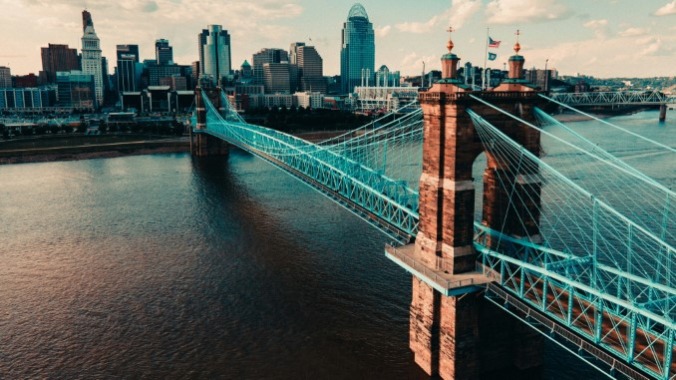
In no other sport is the first day of the season mythologized quite as it is in professional baseball. Perhaps this is a function of acknowledging what a long haul each team is setting out on, a ridiculously punishing 162 game grind that won’t reach its conclusion for more than six months. In a season so long, the promise of Opening Day is eternally quixotic–who knows where your squad will be, half a year from now? Who knows what kind of magic, or tragedy, or exultation might be in store for them?
Baseball fans all over the country have enshrined their own Opening Day traditions in various cities, and it’s one of those days when you know you’ll be running across jerseys and hats in abundance, particularly where fandoms are strongest and most vociferous. Cities like St. Louis, Baltimore, Chicago or Seattle are models for Opening Day enthusiasm. But all of those celebrations pale in comparison with the absolute outpouring of optimism that is Opening Day in the city of Cincinnati, Ohio. This is a place where the concept of Opening Day has grown far beyond even its supposed sporting connotations, becoming a universally celebrated local holiday that brims with infectious joy even for those with no interest whatsoever in baseball.
That Opening Day energy is something difficult to encapsulate without seeing it first hand for yourself, as I recently did on a visit to Cincinnati. From the early hours of the morning, the urban cityscape of Cincy becomes drenched in the color red, as a slow trickle quickly develops into throngs of jubilant residents–many of them already intoxicated–crowding the streets. The Cincinnati Reds gear is everywhere, achieving a level of saturation I’ve never seen in any other random sampling of a city population. Miles away from the confines of the Great American Ball Park on the Ohio River, it seems like at least four out of every five people is in some form of Reds gear.
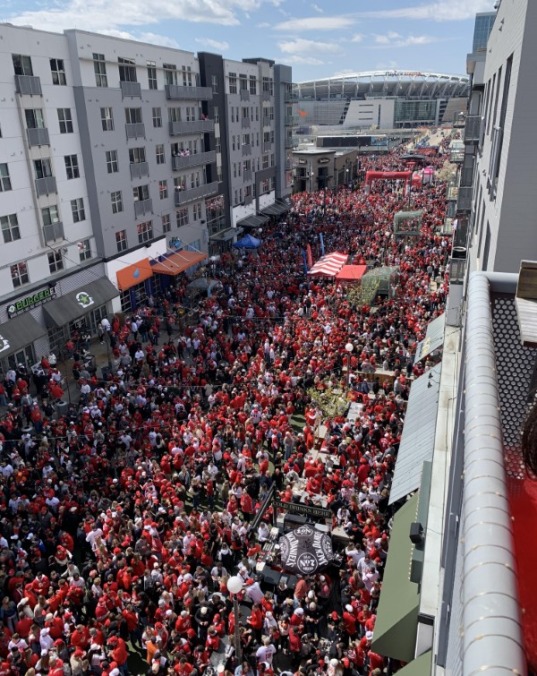
Thousands of fans in red make their way toward the Great American Ball Park.
And yet the oddest thing is how incidental it actually feels in the moment to the world of Major League Baseball–you see the omnipresent hats and shirts, but it doesn’t necessarily feel like just a statement of support for a baseball team. Instead, the overwhelming feeling is of a rare moment of solidarity the city is experiencing that encompasses the entire culture of this corner of Ohio, an armistice in the bitter partisan divide of modern political tribalism that is present literally everywhere else. Opening Day feels almost pagan in this place; a bacchanalia celebrating the city’s annual rebirth. People call off work en masse. Kids are kept home from school. Strangers laugh and embrace each other on street corners.
And of course, that intensity of jubilation is matched only by the eerily empty city streets the following day, a collective day of recovery as the entire population nurses a simultaneous hangover. They say that shared pain brings us all closer together, right?
Cincinnati’s Opening Day Roots
It is fitting that Cincy should be so intimately associated with Opening Day celebrations, given that one of the city’s many claims to fame is as the location for the first ever all-professional baseball team. The group that would go one to become the modern day Reds was founded in 1866, and became a charter member of the newly formed National League in 1876. Ironically, they were eventually expelled from that early version of the NL for the most Cincinnati-appropriate reason imaginable: They refused to sign on to a leaguewide pledge to ban beer sales at games, infuriating league organizer William Hulbert. Cincinnati club president W. H. Kennett refused to sign the pledge to eschew beer (and Sunday games) thanks to the city’s prominent German population, who formed a core constituency of the fanbase and unsurprisingly brought beer culture with them wherever they went. The team was thus expelled from the NL in 1880, became a character member of the newly formed American Association league, and ultimately returned to the NL in 1890, the beef over beer apparently having been forgotten. They’ve remained there ever since.
In that moment of glorious return to what would officially become Major League Baseball in 1903, shouts of “prost!” were no doubt being heard ringing throughout the neighborhood that even then was already known as Over-the-Rhine. Today often shortened to “OTR,” it’s one of Cincy’s 52 neighborhoods, but one of outsized historical and cultural importance in both the Cincinnati of yesterday and today. Initially developed in the mid-1800s, its title was derived from the preponderance of German settlers, who filled the area with the businesses that became its calling card: Numerous breweries, hog butchers and taverns. Boundaried by the Miami and Erie Canal (now Central Parkway), residents began calling the area Over-the-Rhine by comparing the canal to Germany’s Rhine River. The area grew at a breakneck pace in the 1800s, becoming one of the most densely populated urban centers in the entire country, dotted with drinking establishments to offer an escape from cramped tenements. Today, OTR’s 943 intact historical buildings, known for their distinctive Italianate architecture, make it the largest intact historical district in the USA.
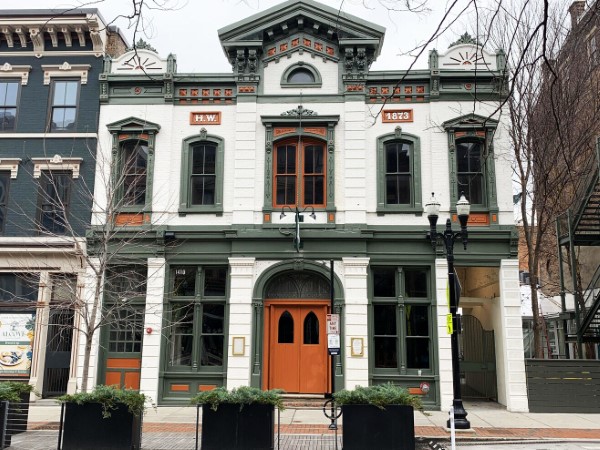
The city never lacks for beautiful places to have a beer.
Nor have the drinking establishments been curtailed, as the area revitalized throughout the 2000s is now once again home to numerous breweries and bars that make up one of the prime centers of Cincinnati’s nightlife. In that process, lost links to the city’s boozy past continue to be uncovered, particularly in the form of a network of “beer tunnels” that have been discovered throughout the neighborhood over the last two decades. These room-sized shafts were excavated by the area’s German brewers for the steady cellar temperature environment they could provide for fermenting lager, but detailed records of their locations were subsequently lost in the 1884 destruction of the county’s courthouse via fire. Today, residents are still hunting for more of the tunnels (and tour guides lead curious visitors through them), but although 12 sets of tunnels have been discovered, it is theorized that five times as many are still sitting undisturbed in the darkness. Several have even been retrofitted as modern businesses, such as the hip speakeasy known as Ghost Baby, where an unusually lofty beer tunnel doubles as a cabaret-esque live music venue.
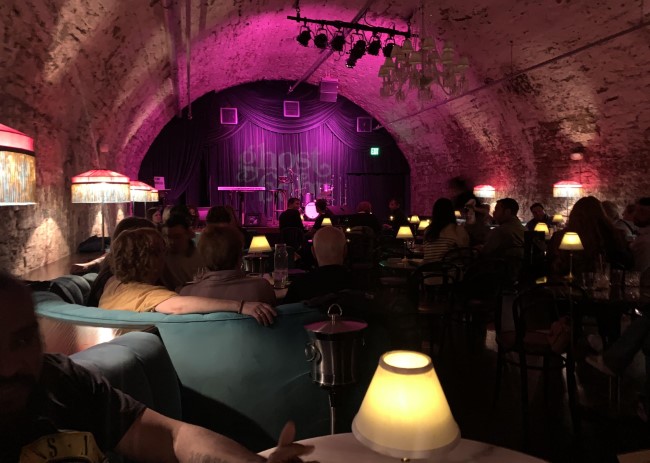 Formerly a beer tunnel, now an underground cocktail bar in Over-the-Rhine.
Formerly a beer tunnel, now an underground cocktail bar in Over-the-Rhine.
OTR is likewise home to Findlay Market, the oldest continuously operated public market in the state, which takes on special significance as the originating site of the grandiose Opening Day Parade each spring. The myriad shops and restaurants of the market are represented in the hours-long parade, marching south through Downtown Cincinnati to wrap itself around Fountain Square, where revelers in crimson await them. One bar owner described the scene succinctly enough, when I asked him about the Opening Day vibe: “It’s like St. Patrick’s Day in red.”
Going Beyond the Ohio
If you’ve never been to Cincinnati, the tendency is to simply have a popular conception of it as an isolated city in Ohio, when in reality it functions as an anchor around which communities are built in two states rather than one. On the immediate opposite side of the Ohio River, with clear sightlines to the Great American Ball Park, are the twin cities of Covington and Newport, Kentucky, which can feel both like Cincy suburbs but also independent entities in some pretty significant ways. As it so often does, one of the major defining qualities comes back to alcohol: The Covington-Newport urban area forms the northernmost part of the Kentucky Bourbon Trail, which is a major tourism driver for the entire region. Nor is the area content to simply pick up those who stray from the major bourbon regions of Louisville, Lexington and Bardstown–instead, Northern Kentucky promotes Covington and Newport as the center of the B-Line, a Kentucky Bourbon Trail sub-region of its own anchored by 7 distilleries, 9 bourbon bars and 9 bourbon-centric restaurants in the immediate area. Ohio residents who are whiskey enthusiasts certainly know the area as a fertile ground for their bottle hunting–particularly because Kentucky operates with significantly less restrictive liquor laws than the state-run system in Ohio. For the bourbon-collecting Reds fan, a quick trip over the river can be quite fortuitous.
But of course, that has always been the case for Newport in particular, a burg once known as America’s original “sin city” before the rise of Las Vegas. Likewise dubbed “Cincinnati’s playpen,” the sleepy town became a bustling hub of illicit enterprise and mob-connected industry during the federal prohibition of alcohol in the United States between 1920-1933. Notorious bootlegger George Remus kept residence in Cincinnati but ran much of his smuggled booze through Newport, where following Prohibition casinos and brothels flourished in an atmosphere of scandalous frivolity. Local casino owners and mob-connected bosses managed to successfully keep local officials on their payrolls until the early 1960s, when the vice industry migrated en masse to the friendlier desert confines of Las Vegas, but the legacy of these industries still draws mob-curious tourism to Newport to this day. Meanwhile, the modern spirits industry here finds its anchor in the likes of New Riff Distilling, which in the last decade has grown from a brand new venture into one of the most successful Kentucky whiskey producers of the bourbon boom era.
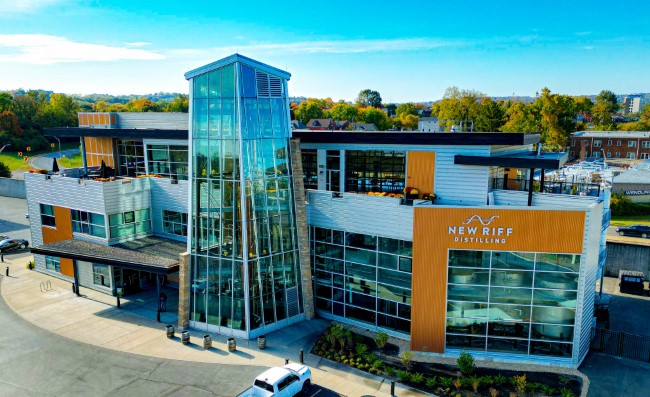
Covington, on the other hand, feels like a more metropolitan little brother to Cincy across the river, featuring a wide array of B-Line businesses that range from bars, to restaurants, hotels and more eccentric stops. Any self-respecting whiskey geek would particularly want to set aside some time to visit Revival Vintage Bottle Shop, where owner Brad Bonds shows off a boggling collection of “dusties” and charges surprisingly fair prices for visitors to sample small drams of bourbon and other spirits from the 1980s, 1970s and beyond. Ever wonder what a vintage bottle produced during American Prohibition actually tasted like? Well, this is one of the few places you’d actually have a chance to potentially experience it for yourself, though you’ll pay a nice chunk of change for the experience. As a tiki cocktail geek, a particular highlight for myself was getting a chance to sample some Barbados rum from the 1960s, while imagining that perhaps it was the kind of thing that “Trader Vic” Bergeron Jr. might have been sipping while observing his burgeoning tiki bar empire booming in postwar America. Suffice to say, this is not an experience you can replicate in many other places.
And of course, the Opening Day energy extends its tendrils southward into Kentucky as well. There, the night before the Reds were to take the field for the first time in the 2024 baseball season, while sipping whiskey at B-Line stop Old Kentucky Bourbon Bar, I met a man (covered head to toe in Reds gear, naturally) named Kiefer whose nickname hinted at his very specific way of generating enthusiasm for Cincinnati’s big day: They called him “The Muffin Man.” Perched at the corner of the bar, Kiefer was in his element, distributing freshly baked peanut butter and chocolate chip muffins to everyone in attendance, a patron saint of the particular esprit de corps that animates the Cincy Opening Day faithful. It was a small thing, perhaps, but perfectly indicative of a unique moment of collective goodwill that this city in Ohio seems to experience every spring when the weather warms and baseball returns.
In the end, it doesn’t matter where you are in the Cincinnati area on Opening Day–only that you’re there with a smile on your face, hope in your heart, and no aversion to the color red.
Jim Vorel is a Paste staff writer and resident brown liquor geek. You can follow him on Twitter for more drink writing.



































